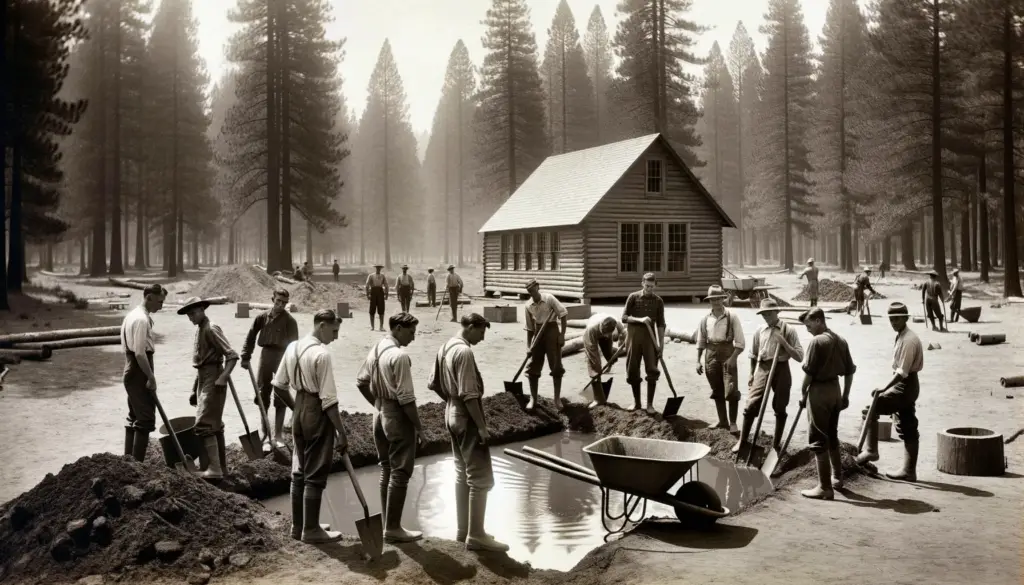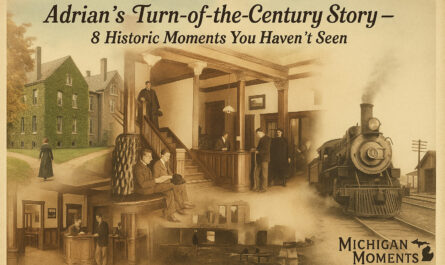Atlanta, Michigan, is more than just a small town; it’s a treasure trove of history. This article will guide you through the historic landmarks in Atlanta Michigan that make this little town a must-visit.
Nestled in the heart of northern Michigan, Atlanta is a small town teeming with a rich tapestry of history and culture. Be it little out-of-the-way spots like the Little Michigan ponds on the site of Camp Lunden or popular landmarks such as the Brush Creek Mill, Atlanta’s heritage is steeped in dynamic experiences from various periods. While the Elk Capital of Michigan provides an intriguing insight into Atlanta’s unique relationship with its abundant wildlife, treasures like the Old Bailey Schoolhouse offer a glimpse into the town’s fascinating educational past. Diving into these topics offers an enriching journey into Atlanta’s past and the vibrant threads that continue to shape its present.
Table of Contents
Little Michigan At Camp Lunden – The CCC Remembered
Nestled along County Road 612, between Lewiston and M-33, lies a curious relic of Michigan’s past: a set of small ponds shaped like the Great Lakes. These ponds are the remnants of Camp Lunden, a Civilian Conservation Corps (CCC) camp established in the 1930s.
The Birth of Camp Lunden

A few months after President Franklin Roosevelt initiated the CCC in 1933, Camp Lunden was born. It was one of 103 such camps in Michigan aimed at providing employment during the Great Depression. Men arrived at the camp to train as draftsmen and civil engineers.
The Making of Little Michigan
In their free time, these men took to a unique project: they dug ponds at the camp’s entrance, shaping them to resemble Michigan’s iconic Great Lakes. This artistic endeavor was more than just a pastime; it became a lasting tribute to the state they were serving. The camp was eventually closed in 1936, but the dry ponds remain, along with a historical marker commemorating the site.
Why It Matters
The CCC was instrumental in constructing roads and maintaining forest lands in Michigan. Over 8,000 men were employed in various camps throughout the state. Camp Lunden was not just a place of employment but a hub of creativity and ingenuity. The “Little Michigan” ponds are a testament to the spirit of the CCC workers who combined their skills and passion to leave a lasting imprint on the land.
Miniature Michigan – A Hidden Gem
Interestingly, this miniature Michigan is not just a roadside attraction; it’s a piece of living history. If you’re ever in the Lewiston area, you can visit the site at 11022 Co Rd 612. For those who can’t make the trip, this small wonder is even visible from space, adding another layer of intrigue to its story.
A Mini Great Lakes On the Side of the Road
The story of Camp Lunden and its miniature Michigan serves as a poignant reminder of a challenging period in American history. It also highlights the resilience and creativity of those who lived through it. As we drive past these small, unassuming ponds, we’re not just passing a geographical oddity but a piece of Michigan’s rich history.
The Brush Creek Mill
The Brush Creek Mill: A Testament to Atlanta’s Past
Situated within the scenic surroundings of Atlanta, Michigan, the Brush Creek Mill stands as an enduring symbol of the community’s industrious past. Throughout its long history, the Mill has played vital roles in the region’s development, initially as a grain mill and later as a power station and an electrical light producer. More than merely an industrial workhorse, the Mill exemplifies the region’s innovative spirit and the perseverance of its people. Over time, the Brush Creek Mill has transformed from a manufacturing mainstay into a cherished landmark, where the community’s history is not merely stored but actively celebrated and shared.
Architecture and Restoration
The Brush Creek Mill is notable for its traditional architecture, reminiscent of American milling history. It showcases a simple yet sturdy style, with a robust exterior built majorly from exceptional Midwest lumber. The structure itself bears testimony to the crafting skills prevalent in its era. Its present form symbolically reflects the perseverance and practicality of the millers past who made a living from this building.
However, age and use took their toll on the historical structure, leading to the need for restoration. Over recent years, concerted efforts have been made to restore and maintain the mill. Committed volunteers and local and state organizations have heavily involved in ensuring that this piece of American history is not lost.
Brush Creek Mill: A Historic Landmark with a New Role
After undergoing extensive renovations, the Brush Creek Mill in Atlanta, Michigan, has been revitalized as a vibrant community center. Today, the mill hosts a diverse range of events and offers a variety of cultural and educational activities. This new purpose has enhanced its historical importance, serving as a gathering place for folks to exchange stories, learn, and honor their collective heritage. Although its function has evolved, the Mill remains an indispensable component of the town’s historic storyline, continuing to symbolize Atlanta’s tenacity, future-oriented mindset, and deep reverence for its historical origins.
Elk Capital of Michigan

Atlanta, Michigan: Renowned as the Elk Capital
Nestled in the northern region of the state, the small town of Atlanta, Michigan is famed as the Elk Capital. This isn’t just a slick tagline. It is an acknowledgement of Atlanta’s unique bond with the elk population. Elk were initially reintroduced in Michigan in 1918, in the vicinity of Wolverine. Since then, well-managed hunting policies and sustainable resource utilization have led to an expansion in the elk count. Consequently, elk have become an integral facet of daily life for the residents of Atlanta.
Elk Viewing Area and Atlanta’s Development
Moreover, the presence of these large mammals has greatly influenced the town’s development. To promote tourism and give visitors a chance to catch a glimpse of these majestic creatures in their natural habitat, the Michigan Department of Natural Resources established the Elk Viewing Area. Located northeast of Atlanta, this viewing area draws tourists from around the world and charges no admission fee, making it both an economic and recreational asset to the community. This popular attraction not only reflects on the town’s history intertwined with the elk, but it also continues to be significant in the present, playing a key role in the local economy, cultural identity, and outdoor recreational offerings of Atlanta, MI.
Fascinating History of Atlanta, Michigan’s Elk Population
The abundant elk population in Atlanta, Michigan, plays a unique role in forming the city’s rich history and culture. These majestic creatures aren’t just an integral part of the region’s natural wilderness, but they also oozes with historic significance. Their recovery to formidable numbers from the brink of extinction is a testament to successful conservation and responsible wildlife management efforts. In addition to their ecological value, the elk have grown into cultural symbols and local landmarks, marked by the city’s annual Elk Festival. The unbreakable bond between Atlanta’s residents and the local elk population contributes significantly to the city’s historical narrative.
The Old Bailey School Schoolhouse

A symbol of Atlanta’s education history is the Old Bailey School, a time-honored landmark situated in the heart of the town. Established back in 1907, the iconic country schoolhouse instructed Atlanta’s youth, spanning one through eight grades, for over six decades until it closed its doors in the mid-1960s. This esteemed institution stands as a reminder of simpler times, representing a era when Atlanta, along with other rural Michigan towns, had a plethora of scattered schools. Over time, the evolution of educational norms and consolidation of school districts led to the closure of such small-scale institutions, making way for larger, more centralized schools.
Preservation and Current Role of The Old Bailey School
After the school’s closure, it remained unused and started deteriorating, until the Brush Creek Mill, a local historical society, bought the school in 2002. With years of renovations and repairs completed in 2007, the 100-year-old schoolhouse was fully restored, preserving its original structure, chalkboards, and antique student desks. Today, The Old Bailey School is listed in the State Register of Historic Sites and stands as a historical museum in Atlanta, Michigan. The museum provides visitors with a glimpse of education during the early 20th century, displaying historical educational artifacts and memorabilia. The Old Bailey School, thus, continues to educate, but this time it serves to inform visitors about Atlanta’s educational past and its role in shaping the community.

As home to landmarks like the Old Bailey School and Brush Creek Mill, Atlanta, Michigan acts as a custodian of history, providing a vivid snapshot of past societal structures, industrial accomplishments, and educational ethos. Coupled with this embrace of its own past, the town’s association with elk herds underlines Atlanta’s harmonious coexistence with nature, a legacy that continues to intrigue and attract visitors. These narratives, preserved and promoted by champions like the Atlanta Area Historical Society, do more than simply recount a linear progression of events. They provide living, breathing channels of connection to the roots of the town, enhancing our understanding of how far it has traveled on its historical journey, and shaping the vision of its future.
Final Thoughts About Historic Landmarks In Atlanta Michigan
In a nutshell, Atlanta, Michigan, offers a rich tapestry of history through its landmarks. Whether you’re a history buff or just curious, Atlanta has something to offer.
Related Reading

Exploring the Beauty of Clear Lake State Park, Atlanta Michigan
Unmissable Annual Events in Atlanta, Michigan




Seeing how much work you put into it was really impressive. But even though the phrasing is elegant and the layout inviting, it seems like you are having trouble with it. My belief is that you ought to try sending the following article. If you don’t protect this hike, I will definitely come back for more of the same.